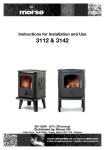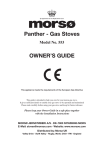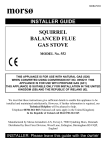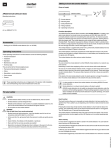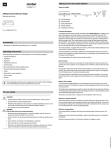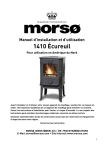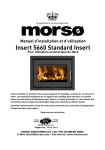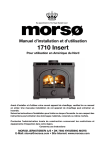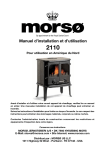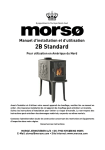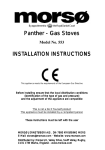Download MORSO Squirrel Model No 551 with open flue Gas Installation
Transcript
Squirrel - Gas Stoves Model No. 551 - With Open Flue INSTALLATION INSTRUCTIONS This appliance is for use with natural gas (G20) When converted using conversion kit no. 555111 this appliance is for use with propane gas (G31) This appliance is suitabel only for use in the United Kingdom (GB) and the Republic of Ireland (IE) only. We trust that these instructions give sufficient details to enable this appliance to be installed and maintained satisfactorily. However, if further information is required, our Technical Helpline will be pleased to help. Telephone 01788554410 (National call rates apply in the United Kingdom). Installer: Please leave this guide with the owner Manufactured by Morsø Jernstøberi A/S . DK-7900 Nykøbing Mors E-Mail: [email protected] · Website: www.morsoe.com Distributed by Morsø UK, Unit 5, io Center, Valley Drive, Swift Walley, Rugby, Warks, CV21 1TW - www.morsouk.com LIST OF CONTENTS Section Heading Page 1. SAFETY 3 2. APPLIANCE DATA 3 3.GENERAL INSTALLATION REQUIREMENTS 4 4. STOVE LOCATION 6 5. GAS SUPPLY CONNECTION 6 6. PACK CONTENTS 7 7. IGNITION CHECK 7 8. FITTING THE CERAMIC FUEL EFFECT AND BURNER COMPARTMENT WALLS 8 9. FINAL CHECKS 10 9.1 Checking the full operating sequence. 10 9.2 Checking the reference pressure. 11 9.3 Check for spillage 12 10. FINAL REVIEW & SERVICING 13 1. SAFETY Installer Before continuing any further with the installation of this appliance please read the following guide to manual handling. • The lifting weight of this appliance is 53.5 kg. • This stove is heavy. We therefore recommend that two people should be sufficient to lift the stove. If fitting or moving the appliance alone we recommend the use of suitable lifting apparatus. • When lifting always keep your back straight. Bend your legs and not your back. • Avoid twisting at the waist. It is better to reposition your feet. • Avoid upper body/top heavy bending. Do not lean forward or sideways whilst handling the stove. • Always grip with the palm of the hand. Do not use the tips of fingers for support. • Always keep the stove as close to the body as possible. This will minimise the cantilever action. • Use gloves to provide additional grip. • Always use assistance if required. 2. APPLIANCE DATA This product uses fuel effect pieces, burner compartment walls and gaskets containing Refractory Ceramic Fibres (RCF), which are man-made vitreous silicate fibres. Excessive exposure to these materials may cause temporary irritation to eyes, skin and respiratory tract. Consequently, it makes sense to take care when handling these articles to ensure that the release of dust is kept to a minimum. To ensure that the release of fibres from these RCF articles is kept to a minimum, during installation and servicing we recommend that you use a HEPA filtered vacuum to remove any dust and soot accumulated in and around the stove before and after working on the stove. When replacing these articles we recommend that the replaced items are not broken up, but are sealed within a heavy duty polythene bag, clearly labelled as RCF waste. This is not classified as “hazardous waste” and may be disposed of at a tipping site licensed for the disposal of industrial waste. Protective clothing is not required when handling these articles, but we recommend you follow the normal hygiene rules of not smoking, eating or drinking in the work area and always wash your hands before eating or drinking. This appliance does not contain any component manufactured from asbestos or asbestos related products. Gas Natural (G20) Inlet Pressure 20mbar Input Max. (Gross) 5.7 kW (19,450 Btu/h) Min. (Gross) 1.7 kW (5,800 Btu/h) Output Max. (Gross) 3.8 kW (12,970 Btu/h) Min. (Gross) 1.1 kW (3,755 Btu/h) Burner Test Pressure (Cold) 19.6 +0.75mbar (7.86 ± 0.3 in w.g.) Gas Connection 8 mm pipe Burner Injector Cat. 82 Size 360 Ignition Piezo Electric. Intergral with Gas Tap Gas rate 0.539m3/h Efficiency class 2 * When converted using Kit no. 555211. Propane (G31)* 37mbar 5.1 kW (17,400 Btu/h) 1.9 kW (6,485 Btu/h) 3.6 kW (12,285 Btu/h) 1.2 kW (4,095 Btu/h) 35.9+0.75 mbar (14.41 ± 0.3 in w.g.) 8 mm pipe Cat. 92 size 160 Piezo Electric. Intergral with Gas Tap 0.190m3/h 2 The stove dimensions are shown in figure 1 3. GENERAL INSTALLATION REQUIREMENTS The installation must be in accordance with these instructions. For the user’s protection, in the United Kingdom it is the law that all gas appliances are installed by competent persons in accordance with the current edition of the Gas Safety (Installation and Use) Regulations. Failure to install the appliance correctly could lead to prosecution. The Council for the Registration of Gas Installers (CORGI) requires its members to work to recognised standards. In the United Kingdom the installation must also be in accordance with: a) All the relevant parts of local regulations. b) The current edition of the Building Regulations issued by the Department of the Environment and the Welsh Office or the Building Standards (Scotland) Regulations issued by the Scottish Development Department. c) All relevant codes of practice. d) The relevant parts of the current editions of the following British Standards:BS 1251 BS 5440 Part 1 BS 5440 Part 2 BS 5871 Part 1 BS 6891 BS 8303 In the Republic of Ireland the installation must also conform to the relevant parts of: a) The current edition of IS 813 b) All relevant national and local rules in force. c) The current building regulations. Where no specific instructions are given, reference should be made to the relevant British Standard Code of Practice. The hearth must be made from a non-combustible material and be at least 400mm wide x 420mm deep x 12mm thick. Clearances from combustible and non-combustible materials must be at least those shown in figure 1. Figure 1 The flue details are shown in figure 1. • The minimum flue diameter is 120mm. • The minimum flue height is 3m. • The maximum horizontal flue length is 300mm. • No restrictor plate or flue damper is permitted. Where a variable damper is fitted it must be removed or be permanently fixed in the open position. • The flue must be swept before the appliance is installed. Ventilation: Normal adventitious ventilation is usually sufficient to satisfy the ventilation requirements of this appliance. In GB reference should be made to BS 5871 Part 2 and in IE reference should be made to the current edition of IS 813 “Domestic gas Installations” which makes clear the conditions that must be met to demonstrate that sufficient ventilation is available. Location: This appliance must not be installed in a private garage or any room, which contains a bath, or shower or where steam is regularly present. Propane gas appliances must not be installed in a cellar, basement or other room which is built entirely below ground level (See Gas Safety (Installation & Use) Regulations). A fireguard complying with BS 8423 should be fitted for the protection of young children, the elderly, or the infirm. Such a guard is also recommended for the protection of pets. Atmosphere sensing device. The appliance is fitted with an A.S.D (Atmosphere sensing device). If the appliance closes down after a period of operation for no apparent reason, the consumer should be informed to stop using the appliance until the installation and appliance have been thoroughly checked. The A.S.D will shut the appliance down if an unacceptable amount of harmful products of combustion accumulate. Under no circumstances should the A.S.D be altered or bypassed in any way. Only a genuine manufacturers replacement part should be fitted. The individual A.S.D components are not replaceable. 4. STOVE LOCATION 1. Decide on whether the stove is to be used in rear or top outlet set-up and remove the appropriate outlet cover plate. The cover plate must be securely attached to the unused flue outlet. 2. Place the stove in position on the hearth ensuring that the minimum di- mensions specified in figure 1 are adhered to. Connect the flue pipe to the outlet and seal in place. 3. Due to its weight there is normally no requirement for additional fixing with this appliance. 5. GAS SUPPLY CONNECTING • A nut and olive are provided for an 8mm pipe inlet connection to the elbow at the bottom front of the appliance. The elbow can be rotated to allow a connection from any direction. The elbow includes a valve for isolating the gas supply. • The supply pipe must be rigid material. Flexible pipe must not be used. • Note: Prior to connecting the gas supply it is advisable to blow out the gas supply so that any dirt which may be present in the pipe is cleared and cannot enter the gas valve or pilot burner and so cause a blockage. • With the supply connected pressure check the installation pipework for gas soundness. In the United Kingdom check in accordance with the current edition of BS6891. In the Republic of Ireland check in accordance with the rules in force. 6. PACK CONTENTS 1 Cast iron stove containing gas burner unit & interior flueway 1 8mm nut & olive 1 Key for door 1 Rope seal 2 Ceramic base pieces 1 Set of 7 coals 1 Pair of ceramic firebox side walls 2 Side wall retaining brackets 1 Ceramic firebox back wall Remove all the items carefully to prevent damage. Take special care when handling the ceramic components. Some items may be contained in the packaging fitments - Examine the packaging carefully before discarding. Check that all the items are present and undamaged. 7. IGNITION CHECK Before attempting to install, it is worth checking that the ignition system performs satisfactorily. Set the right hand control knob to the off position marked •. Depress the right hand control knob and rotate it anticlockwise through the ignition position marked to the pilot ignition position marked . A ‘click’ will be heard as the integral piezo operates. A spark should be seen between the electrode and pilot tip. If there is no spark check the following: • Ensure that the electrode lead is connected to the terminal at the base of the electrode. • If the above is correct, check for damage to the electrode lead. 8. FITTING THE CERAMIC FUEL EFFECT & BURNER COMPARTMENT WALLS 1. The door is secured with a locking screw. Remove the screw with the allen key supplied (See figure 2). Open the door. 2. Remove the front grate. To do this, hold firmly and lift. 3. Place the rear ceramic wall against the back of the firebox. 4. The rear ceramic wall must be located onto the ledges at the back of the rear base ceramic (See figure 3). To achieve this, hold the rear ceramic wall against the rear of the firebox at its uppermost position. Whilst holding the rear ceramic wall in this position locate the rear ceramic base coal into position (See figure 3). The rear wall can now be released. Ensure that the rear ceramic wall sits on the ledge at the back of the rear base coal. 5. Fit the left hand side wall against the left hand side of the firebox. Locate the bottom of the side wall into the channel along the bottom of the firebox (See figure 4). Supplied with the stove are two ceramic retaining brackets. One for each side of the firebox. Hold the ceramic side wall against the steel firebox plate and slide the long leg of a retaining bracket behind the steel firebox plate. Push down to hold the ceramic side wall in place. 6. Fit the right hand side wall against the right hand side of the firebox. Locate the bottom of the side wall into the channel along the bottom of the firebox. Hold the ceramic side wall against the steel firebox plate and slide the long leg of a retaining bracket behind the steel firebox plate. Push down to hold the ceramic side wall in place. 7. On the front of the burner there is a bracket for supporting the front ceramic base. At the rear of the front ceramic base is a recess. Fit the front ceramic base piece locating the recess onto the forward projecting part of the burner bracket (See figure 5). There are seven overlay coals. There are three ceramic coals identified with the number’1’. Two identified with the number ‘2’ and two identified with the number ‘3’. 8. Locate one of the ceramic coals identified with a number ‘1’ as in figur 6. 9. Locate the two ceramic coals identified with a number ‘2’ as in figure 7. 10. Locate the remaining two ceramic coals identified with a number ‘1’ as in figure 8. 11. Locate the two ceramic coals identified with a number ‘3’ as in figure 9. 12. Replace the front grate previously removed . 13. Close and secure the door by refitting the locking screw. Figure 3 Figure 2 Figure 4 Figure 5 Figure 6 Figure 7 Figure 8Figure 9 9. FINAL CHECKS Figure 10 9.1 Checking the full operating sequence. See figure 10. If the fire is turned off or the flames go out, wait at least 3 minutes before attempting to relight. A safety device in the control stops the fire being turned back on until it is safe. 10 • Turn the left hand control knob fully clockwise. • Push in the right control knob and, while keeping it depressed, turn anticlockwise through the ignition position marked and up to the pilot position marked . The spark should light the pilot. • If the pilot does not ignite, keep the knob depressed for a few seconds to purge air from the supply pipes. Then turn back to the off position marked • and repeat the ignition procedure. • When the pilot has lit, keep the right hand control knob depressed for a few seconds to allow the pilot flame to stabilise then release it. If the pilot does not remain alight ensure that the air has been purged. • Partially depress the right control knob and turn to the main burner position marked . The main burner should now light at its low position. • The left-hand knob is for burner flame adjustment. Turning it anticlockwise should gradually increase the flame height. • The flame height control does not have to be re-set every time the fire is lit. It can be kept at any position enabling the customer to use the right hand control only to ignite the burner at the set flame height. • After checking turn the right hand knob to off. Depress the control knob partially at the pilot position marked , turn clockwise to off position marked • ! and release the knob. If any resistance is felt when turning, release the downward pressure on the knob before continuing to turn. 9.2 Checking the reference pressure. The burner aeration is non-adjustable. The appliance is preset to give the correct heat input on Natural Gas at 20 mbar (8in w.g) inlet pressure and no further adjustment is necessary. The burner pressure should be checked at the pressure test point located at the side of the control unit (See figure 11). Figure 11 11 The pressure check should be carried out using a calibrated pressure gauge after removing the test point screw. The fire should be alight and the left hand control knob at its fully anticlockwise setting (Maximum flame height). The pressure setting should be within the limits shown on page 3 of this manual (Appliance data). After checking the pressure, turn the fire off, remove the pressure gauge and replace the pressure test sealing screw. Relight the fire and test all gas joints for soundness using a suitable leak detection fluid. 9.3 Check for spillage A spillage check must be made before leaving the installed appliance with the customer. Make this with all the ceramic coals in position. 1. Close all doors and windows in the room containing the appliance. 2. Light the appliance and turn the flame-height control to the maximum position. 3. Leave the appliance on for 5 minutes. 4. Hold a lighted smoke match close to the draught diverter outlet at the back of the stove (See figure 12). Figure 12 5. The installation is satisfactory if the smoke is drawn into the appliance. 6. If the smoke is not drawn into the appliance, leave the appliance alight at the maximum setting for a further ten minutes and then repeat the test. 7. If the smoke is still not drawn into the appliance, turn off the appliance and allow to cool. Check the flue installation and clearance of the draught diverter from the rear surface. If no solution can be found, turn off the appliance and disconnect it. Advise the customer of the problem and stress that the appliance must not be used until the problem is solved. If necessary seek expert advice. 12 8. If the above test is satisfactory, open all internal connecting doors, hatches, etc. in the room. Keep all doors and windows that open to the outside of the building closed. Switch on any extractor fan installed in the same room as the appliance or a connecting room. Open all doors and other openings between the fan and the appliance. Recheck for spillage as above The installation is satisfactory if the smoke is drawn into the appliance. If the test is not satisfactory, turn off the appliance and disconnect it. Advise the customer of the problem and stress that the appliance must not be used until the problem is solved. 10. FINAL REVIEW & SERVICING Final Review • Visually inspect the appliance. Clean off any marks incurred during installation. • Advise the customer how to operate the appliance. Advise the customer that they should read their Owner’s guide before operating the fire and always follow the advice in the section headed “Cleaning your stove”. • Advise the customer that the top, front, sides and back of the appliance are working surfaces and become very hot during use and, therefore care should be exercised, particularly with the young, elderly or infirm. • Explain to the customer that the appliance has a flame failure & spillage monitoring system. Point out the explanation of this system shown in the owner guide under “Operating your stove”. Advise that if the fire goes out for any reason wait at least three minutes before relighting. Stress that if the monitoring system repeatedly shuts off the fire, the appliance should be switched off and a specialist should be consulted. • Advise the customer that the window can be opened for cleaning the interior by using the special key supplied. Stress that the window locking screw should be refitted afterwards to prevent inadvertent opening when the stove is alight. • Stress that no extra ceramic coals must be added over and above those supplied with the appliance and that any replacements must only be the authorised spares. Warn that ignoring this advice could cause incomplete clearance of the products of combustion with consequent health hazards. • Explain to the customer that when operating the stove for the first time, some vapours may be given off which may cause a slight odour and could possibly set off any smoke alarms in the immediate vicinity. These vapours are quite normal with new appliances. They are totally harmless and will disappear after approximately twelve hours use. • Hand these instructions, the owner guide and the door key to the customer. 13 • Recommend that the appliance should be serviced and the flue checked by a competent person (In the UK preferably a CORGI registered person) at least annually. If the appliance is in premises in the United Kingdom occupied by a tenant, point out that by law a landlord must have any gas appliance, flue and pipework which is situated in a tenant’s premises checked for safety at least every 12 months. Servicing • Always turn off the gas supply and allow to cool completely before commencing any servicing. • This product uses fuel effect pieces and burner compartment walls containing Refractory Ceramic Fibres (RCF), which are man-made vitreous silicate fibres. Excessive exposure to these materials may cause irritation to eyes, skin and respiratory tract. Consequently, it is important to take care when handling these articles to ensure that the release of dust is kept to a minimum. To ensure that the release of fibres from these RCF articles is kept to a minimum, during installation and servicing we recommend that you use a HEPA filtered vacuum to remove any dust and soot accumulated in and around the fire before and after working on the fire. When replacing these articles we recommend that the replaced items are not broken up, but are sealed within a heavy duty polythene bag, clearly labelled as RCF waste. This is not classified as “hazardous waste” and may be disposed of at a tipping site licensed for the disposal of industrial waste. Protective clothing is not required when handling these articles, but we recommend you follow the normal hygiene rules of not smoking, eating or drinking in the work area and always wash your hands before eating or drinking. This appliance does not contain any component manufactured from asbestos or asbestos related products. • Check that the appliance is clean and that no matter is blocking the burner or pilot which may cause imperfect flames or prevent a correct electrode spark. • After servicing, make sure that the ceramic walls and fuel effect pieces are replaced correctly as described in this guide. Make sure that the door locking screw is in place. • Always test for gas soundness after servicing the appliance. 14 15 Morsø Jernstøberi A/S - 18.12.2006 - 72146100 16
















